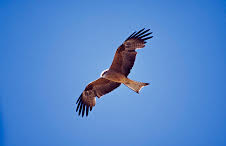Red Goshawk
Erythrotriorchis radiates
Conservation Status
Queensland State: Endangered
Australian Government: Vulnerable
Species and status overview
The Red Goshawk is solitary by nature and is thinly dispersed from the Kimberly along all coastal regions east until northern NSW and an outlying area of central Australia. There appears to have been a recent coastal contraction of the range of the bird in parts of eastern Australia, and a northward contraction of about 500 kilometres in NSW where it is now virtually extinct. Red Goshawk pairs remain within the nesting territory all year, but travel hundreds of kilometres as juveniles from their place of birth.
Since European settlement, about twenty percent of the Red Goshawk habitat has been altered and become unsuitable for breeding, particularly in coastal Queensland. This continues to be the main threat to the bird, with development reducing the availability of large nesting trees and prey.
Areas in which Red Goshawks have been sighted in the region include:
- Charlton
- Mackay
- Finch Hatton
Description
The Red Goshawk is a large, swift and powerful red-brown hawk, growing to a length of 45–60 cm, with a wingspan of 100–135 cm. The males and females of this species are quite different in size and appearance, with females weighing twice that of males. The Red Goshawk can further be distinguished from other similar raptors by its broad ‘six-fingered’ wings that are held at slightly angled planes when soaring.
The Red Goshawk occurs in coastal and sub-coastal areas in wooded and forested lands, which are tropical and warm-temperate. They are typically found in habitats that support high bird numbers that constitute the majority of their prey but they may also feed on mammals, reptiles, and large insects.
The Red Goshawk is a good indicator of highly productive land and biodiversity. If it’s good enough for Red Goshawks, it’s good enough for a whole range of other threatened species that rely on old growth trees for habitat and food.
Conservation concerns
The Red Goshawk has the unfortunate title of Australia’s most threatened bird of prey. Known threats include heavy grazing, frequent burning, or the degradation of freshwater wetlands and riparian areas, which reduce the availability of prey for the Red Goshawk. It is believed there are now fewer than 1000 adult Red Goshawks in Australia.
Habitat destruction and fragmentation for agricultural or industrial purposes remains the most prevalent threat, with fragmentation of habitat a threat as the birds are scarce where lowland forests have been cleared for agriculture. Nests are particularly vulnerable as they are usually found in the tallest trees that are valuable for timber, or are exposed to storm damage and other disturbance.
What can I do?
- Maintain large trees for nesting habitat
- Retain or revegetate riparian habitat
- Manage weeds in the riparian zone, particularly rubber vine
- Maintain or enhance existing habitat through revegetation and appropriate fire management practices
Photo credit Queensland Government
